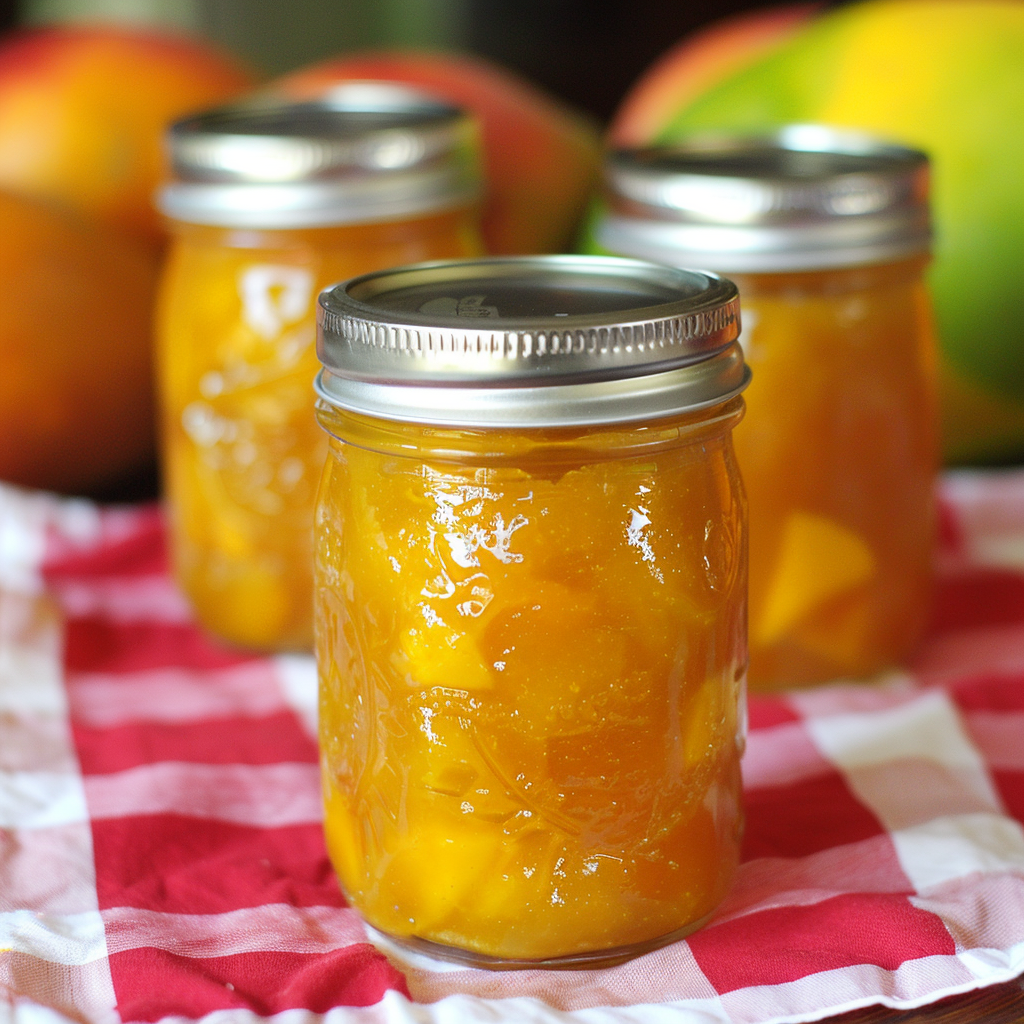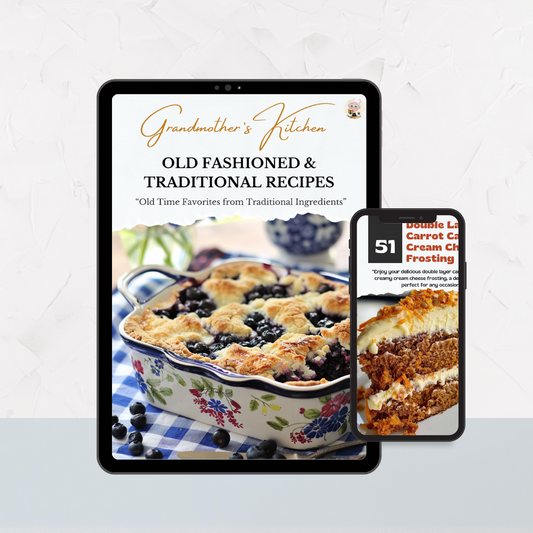Homemade Mango Jam Recipes: Capture Tropical Flavor in Every Jar

Share
Feeling Tropical? Try Mango Jam.
There’s something incredibly satisfying about finding your favorite fruits at a reasonable price, especially when mangoes are in season. I love indulging in them fresh, but I always make sure to save some for a small batch of mango jam. That way, when the craving for that sweet, tropical flavor hits, I can just reach into the pantry and enjoy it anytime. Making a few jars also means I have a thoughtful gift ready for any food event or gathering. I find it’s always fun to bring a jar of homemade jam to the host—it’s a little piece of home that’s always appreciated. Mango jam is a delightful way to capture the essence of summer and preserve it for year-round enjoyment. Whether you prefer a traditional, low-sugar, or freezer method, this guide will help you create a delicious mango jam that can be enjoyed on toast, with cheese, or as a thoughtful homemade gift.
Did You Know?
Mangoes are not only delicious but also packed with vitamins A and C, fiber, and antioxidants. Originating in South Asia, these tropical fruits have been cherished for thousands of years. Making jam with mangoes allows you to enjoy their vibrant flavor even when they’re out of season.
Yield: 5 cups (approximately 10 half-pint jars)
Traditional Mango Jam Recipe
Ingredients:
-
4 cups chopped mangoes
-
4 cups granulated sugar
-
2 tablespoons lemon juice
-
1 package (1.75 ounces) fruit pectin
Instructions:
-
Prepare the Mangoes: Wash, peel, and chop the mangoes. Measure 4 cups of chopped mangoes into a large saucepan.
Personal Tip: Use fully ripe mangoes for the best flavor, as they are sweeter and make for a more flavorful jam.
-
Add Lemon Juice and Pectin: Stir in the lemon juice and fruit pectin. Bring the mixture to a full rolling boil over high heat, stirring constantly.
Personal Tip: Adding all the sugar at once helps to ensure it dissolves evenly.
-
Add Sugar: Add the sugar all at once. Return the mixture to a boil and boil hard for 1 minute, stirring constantly. Remove from heat and skim off any foam.
Personal Tip: Skim off the foam to ensure a clearer jam and better presentation.
-
Fill Jars: Ladle the hot jam into prepared, sterilized jars, leaving 1/4-inch headspace. Wipe jar rims and cover with lids.
Personal Tip: Make sure to leave the correct headspace to allow for proper sealing during processing.
-
Process: Process the jars in a boiling water bath for 10 minutes. Remove and let cool. Check seals after 24 hours. Store in a cool, dark place.
Low-Sugar Mango Jam Recipe
Ingredients:
-
4 cups chopped mangoes
-
1 1/2 cups granulated sugar
-
2 tablespoons lemon juice
-
1 package (1.75 ounces) low-sugar pectin
Instructions:
-
Prepare the Mangoes: Wash, peel, and chop the mangoes. Measure 4 cups of chopped mangoes into a large saucepan.
Personal Tip: Gradually adding the sugar allows for better control over the sweetness level.
-
Add Lemon Juice and Pectin: Stir in the lemon juice and low-sugar pectin. Bring the mixture to a full rolling boil over high heat, stirring constantly.
Personal Tip: Stir constantly to prevent burning and to ensure the pectin dissolves properly.
-
Add Sugar: Add the sugar gradually. Return the mixture to a boil and boil hard for 1 minute, stirring constantly. Remove from heat and skim off any foam.
Personal Tip: Let the jam sit for a few minutes after boiling to allow the flavors to meld.
-
Fill Jars: Ladle the hot jam into prepared, sterilized jars, leaving 1/4-inch headspace. Wipe jar rims and cover with lids.
Personal Tip: Wiping the rims ensures a tight seal and prevents spoilage.
-
Process: Process the jars in a boiling water bath for 10 minutes. Remove and let cool. Check seals after 24 hours. Store in a cool, dark place.
Mango Freezer Jam Recipe
Ingredients:
-
4 cups chopped mangoes
-
1 1/2 cups granulated sugar
-
2 tablespoons lemon juice
-
1 package (1.75 ounces) instant fruit pectin
Instructions:
-
Prepare the Mangoes: Wash, peel, and chop the mangoes. Measure 4 cups of chopped mangoes into a large bowl.
Personal Tip: For best results, let the mixture sit for a few minutes after adding the pectin to allow it to thicken slightly.
-
Add Lemon Juice and Pectin: Stir in the lemon juice and instant fruit pectin. Mix well.
Personal Tip: Make sure the sugar is fully dissolved before pouring into containers to avoid a grainy texture.
-
Add Sugar: Gradually add the sugar, stirring until the sugar is completely dissolved and the mixture is no longer grainy.
Personal Tip: Leave some headspace in the container to allow for expansion when freezing.
-
Fill Containers: Ladle the jam into clean, freezer-safe containers, leaving 1/2-inch headspace. Seal with lids.
Personal Tip: Let the jam sit at room temperature for 24 hours to set properly.
-
Store: Store the jam in the freezer for up to a year or in the refrigerator for up to 3 weeks.
Nutritional Information (Per Tablespoon)
Traditional Mango Jam: Calories: 50, Protein: 0g, Carbohydrates: 13g, Fat: 0g, Sugars: 12g
Low-Sugar Mango Jam: Calories: 25, Protein: 0g, Carbohydrates: 6g, Fat: 0g, Sugars: 5g
Mango Freezer Jam: Calories: 35, Protein: 0g, Carbohydrates: 9g, Fat: 0g, Sugars: 8g
Impact of Using Less Sugar or Honey on Jam Texture
When using less sugar or substituting sugar with honey in jam recipes, the texture of the jam may be affected in a few ways:
-
Setting and Firmness: Sugar plays a crucial role in helping the jam set and achieve the right consistency. It binds with the pectin in the fruit to create the gel-like texture of jam. Reducing sugar or using honey, which has a different chemical composition, can result in a softer set or a more liquid consistency.
-
Cooking Time: Jams with less sugar might require a longer cooking time to reach the desired thickness. However, prolonged cooking can sometimes lead to a more concentrated, potentially caramelized flavor and a darker color.
-
Moisture Content: Sugar helps to draw moisture out of the fruit, which is essential for achieving the right consistency. Using less sugar means more moisture remains in the jam, which can lead to a runnier texture.
-
Preservation: Sugar acts as a preservative by inhibiting the growth of microorganisms. Jams with less sugar might have a shorter shelf life and may need to be refrigerated or consumed more quickly.
-
Texture Adjustments: To compensate for reduced sugar, you can use low-sugar pectin, which is specifically designed to gel with less sugar. Alternatively, cooking the jam longer and ensuring proper sterilization and sealing of jars can help maintain quality.
-
Honey's Water Content: Honey contains more water than granulated sugar, which can also contribute to a softer set. You might need to reduce the other liquid ingredients slightly to compensate.
-
Flavor Profile: Honey has a distinct flavor that can alter the taste of the jam, often adding a floral or caramel note, depending on the type of honey used.
By understanding these effects and making small adjustments, you can successfully create delicious jams with less sugar or honey, while still achieving a pleasing texture and preserving them safely.
Kitchen Tips, Great Ideas, How to Save Money
- Choosing Mangoes: For the best flavor, use fresh, ripe mangoes. Local farmers' markets often have the freshest options, and buying in bulk during peak season can save money.
- Sterilizing Jars: To ensure your jars are properly sterilized, boil them in water for at least 10 minutes before filling. This step is crucial for food safety.
- Lemon Juice: Fresh lemon juice enhances the flavor and helps the jam set. If you don't have fresh lemons, bottled lemon juice works just as well.
- Using a Food Processor: For a smoother texture, use a food processor to chop the mangoes. Just be careful not to puree them completely; a bit of texture is desirable.
- Reducing Foam: A small pat of butter added to the boiling jam can help reduce foaming, making the process easier and the final product clearer.
- Testing for Set: To check if your jam is set, place a small amount on a chilled plate. If it wrinkles when pushed with your finger, it's ready.
- Storage Tips: Properly sealed jars can be stored in a cool, dark place for up to a year. Once opened, keep the jam in the refrigerator and use it within a month.
- Reuse and Recycle: Save money by reusing jars from store-bought products. Just ensure they are properly sterilized before use.
- Gift Idea: Homemade mango jam makes a wonderful gift. Decorate the jars with ribbons and homemade labels for a personal touch.
- Experiment with Flavors: Add a twist to your mango jam by incorporating other fruits, such as pineapples or passion fruit, or spices like ginger or cardamom for a gourmet touch.
Where Are Mangos Grown and How Are They Harvested?
Mangoes are primarily grown in tropical and subtropical regions around the world, with India being the largest producer. They are also cultivated in countries like Mexico, Thailand, the Philippines, and parts of Central and South America. Mangoes thrive in warm climates and are typically harvested by hand when they reach full maturity but are still firm. Farmers carefully pick them to avoid bruising, often using long poles with baskets attached to gently pluck the fruit from high branches. After harvesting, mangoes are sorted, packed, and quickly transported to markets to preserve their freshness.


